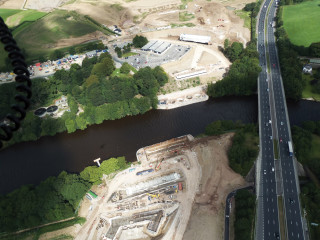The Heysham to M6 Link Road is relatively short at just 4.8km, but it’s been a long time coming. The route was first mooted in the 1948 Road Plan for Lancashire – a full decade before the Preston Bypass (the predecessor to the M6 and the UK’s first motorway) was opened.
Over the decades the scheme has been tossed backwards and forwards by successive governments, both national and local, while the conflicting views of local residents, businesses and environmentalists further hampered progress. No agreement could be reached until 2008, when planning permission was finally granted. That there is a justifiable need for a new link road has never been in doubt. The Heysham and Morecambe peninsula is something of a geographical backwater, the M6 motorway carrying traffic straight past. Currently the two- lane A683 Heysham to Kirkby Stephen trunk route provides the only access by road from the M6 to the main industrial areas of the Port of Heysham and the Heysham nuclear power stations – via the centre of Lancaster and its notorious one-way system. Costain has the main contract to build the new £124.5m Link Road which, though less than 5km in length is nevertheless a complicated scheme, with 11 major structures including road, rail, canal and river crossings.
After a ground-breaking ceremony in November 2013, work on site started the following January and is scheduled to last 30 months, with completion in September 2016. By far the most complicated elements of the scheme are focused on remodelling Junction 34 of the M6, where the new road joins the motorway network. “The road itself is only 4.8km long, but the project includes 4km of new slip-roads,” explains Tom Horton, one of two community liaison officers Costain has working on the scheme. “This part often gets overlooked, but the remodelling of Junction 34 includes some major structures,” he adds. Junction 34 is a notorious accident black- spot, says Horton, with existing slip-roads just 40 – 50m in length meaning abrupt and hazardous conditions as traffic merges on and off the motorway. In fact, Junction 34 was never intended to be a public junction, says Horton. For some far- from-obvious reason, it was originally built as access just for emergency vehicles and only later was it opened to general traffic. Consequently, the junction, and the A683 road into Heysham, have had to accept growing traffic densities. The new Link Road is therefore much anticipated and popular with the local community. “Sixty years on, we’re finally getting our road,” says Horton, who himself hails from Lancaster. Besides providing the vital link to Heysham’s industrial areas, the new road will also reduce congestion in the Lancaster area, especially on Caton Road, Morecambe Road and the Greyhound and Skerton bridges.
The port, the third largest in the North West, is developing as a hub for services to Ireland and is the supply base for major offshore gas fields and wind farms. It’s got a lot of potential and is not tidal-dependent,” says Horton, “but it has never had an adequate road link so has been held back.” The 11 permanent structures along the route range from small bridges taking the new dual carriageway under minor roads to major bridges taking it over the West Coast Mainline, the A6 trunk road, the Lancaster Canal and the River Lune.
Earthmoving has been a major feature of the project, with over 1.7 million tonnes of material excavated along the route by Welsh earthmoving specialist Walters. “The entire job is cut-and-fill,” says Horton. “Everything east of the A6 Lancaster Road is cut, and everything west of the A6 is fill.” The material excavated east of the A6 has therefore been transported west for use as fill. Nearly all of the material excavated has been re- used somewhere on the project, says Horton. Because of the extensive muckshifting movements, it was essential to provide access along the route for Walters’ fleet of articulated dump trucks at the earliest possible opportunity. With the West Coast Mainline and the Lancaster Canal crossing the path of the new road, this meant that two of the major structures – the Folly Railway Bridge and the Milestone Bridge over the canal – had to be structurally complete very early in the programme.
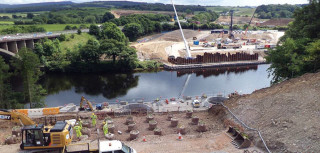
The Folly Railway Bridge was the first major structure to be finished. “We had the first beams laid by December 2014 and the rest by February this year,” says Horton. Site traffic started using the bridge on 30th June, since when Walters has hauled more than 400,000 tonnes of earth across it. In January this year, the first precast concrete arches for Milestone Canal Bridge were lifted into place. With a span of 30m, this is currently the longest unsupported precast concrete arch in the UK, according to Costain. Two other key structures at the extreme eastern end of the scheme – Shefferlands Bridge, carrying the new road over an existing local road, and Carus Bridge, which takes another minor road, Kellet Lane, across the Link Road – were completed over a year ago and are already open to traffic.
Shefferlands Bridge is right in the centre of the new Junction 34. It is located south of the River Lune, as was the entire junction originally. However, the new road meets the M6 motorway via the new Shefferlands Roundabout on the north bank of the river. The north-bound ‘on’ slip-road now leaves this roundabout and joins the motorway further north. The three other slip-roads (north-bound ‘off’ and both southbound ‘on’ and ‘off’) remain south of the river. Spanning the river between Shefferlands Bridge to the south and Shefferlands Roundabout on the north bank is the biggest and most ambitious structure on the project: the Lune West Bridge. Running parallel to - and about 40m to the west of - the existing M6 Lune Bridge, the new structure will carry traffic coming off the north- bound M6 over the river to join the Link Road at the Shefferlands Roundabout. It will also take traffic from the roundabout in the opposite direction to the new park-and-ride south of the river. The 211m-long four-span bridge is a steel structure designed by consulting engineer Jacobs and fabricated by steelwork supplier Cleveland Bridge.

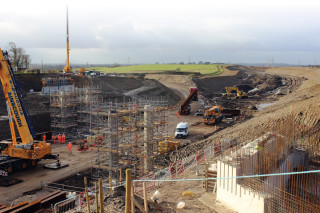
The steel beam sections started arriving on site in March this year and were bolted together into sub-assemblies ready for lifting into place in May. The long, slender beams, just 4.5m deep, were placed in sequence, starting at the north and south abutments and working towards the central 90m span. Sub-assembly at ground level helped reduce the amount of work required to be done at height, but this meant that each assembly weighed up to 350 tonnes. To lift these massive units, Costain called in heavy-lift specialist Sarens, which supplied its 1,200t- capacity Gottwald AK680-3 lattice boom truck crane, believed to be the UK’s most powerful mobile crane (see box, p39). From the north side of the river, four single- girder modules were sub-assembled and lifted into place over the abutments and piers. These units measured 71.6m long by 1.5m wide and weighed 160 tonnes apiece. Once these were installed, the big Gottwald was de-rigged and then reassembled on the other side of the river. From here, the remaining six paired girder modules were installed. Costain made good progress on the contract and was actually ahead of schedule right up until September of this year, when it hit a snag. The 2,300 tonnes of steelwork for the Lune West Bridge was assembled across the river; all pier works were completed and Costain had started laying the reinforced concrete decking when problems arose with the final positioning of the bridge.
At the time of writing (mid-October) the bridge is in limbo, suspended on the 32 hydraulic jacks which will be used to lower the structure in a controlled sequence onto its permanent bearings. It is this operation that has proved problematic: “This is a technically challenging phase that required a number of sequenced de-jacking operations to transfer the load around the structural members until it rests in its final position and takes its final shape,” says Costain’s construction manager Richard Helme. “The project team became aware of some unexpected readings and have suspended the works until further checks can be carried out with regards to the temporary position. “It’s a bespoke design – long and slender – and the geometry is complicated,” adds Helme. Having got this far without a major hitch, it is frustrating for Helme and his team to see the bridge pre-cambered and suspended a tantalizing 150mm above its bearings. “We just need to lower it now – but we only get one chance, so it’s got to be right,” he says.
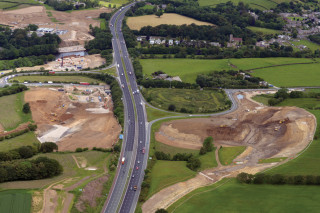
The proposed methodology has been submitted to an independent consultant for a Category 3 check, explains Helme: “We’ve got a solution; we’ve just got to get it signed off. It’s not really a new methodology; it is expected to basically be the same but with more assessments to confirm the position and loadings as lowered. “We are always monitoring the progress,” continues Helme. “We have had a bit of luck with regards to the weather and this has helped us to get the road construction into a good programme position. This structure is on the critical path and we are investigating and considering the programme options - as we always would - to speed up the process and allow the scheme to be successfully completed as early as possible. “Although this is a set-back for the project, it is one that we will be working hard to get over and attempting to recover during the remaining duration. We shouldn’t forget that this is one engineering challenge amongst a large number that we have successfully faced to date on the project.”
Big Lifter
The crane used to lift the Lune West Bridge beams into place is the 1,200t- capacity Gottwald AK680-3, owned and operated by the UK arm of Belgian heavy lifting specialist Sarens.
Rigged with 89m of main boom, a 43m back mast and almost 600 tonnes of counterweight, the AK680 lifted the 2,300 tonnes of steel bridge beams in sections weighing from 160 tonnes to 360 tonnes. Rigged in this configuration, the crane can lift 100 tonnes to a radius of 100m. “There were several reasons for using a truck crane rather than a crawler,” says Chris Horan, Sarens UK’s project manager. “The truck-mounted crane is much faster to rig and de-rig which was paramount with lifts each side of the River Lune within such a tight deadline. “Although now more than 30 years old, the crane has recently been totally refurbished and still remains the strongest crane of this category,” says Horan.
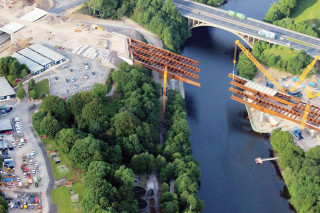
Got a story? Email news@theconstructionindex.co.uk

